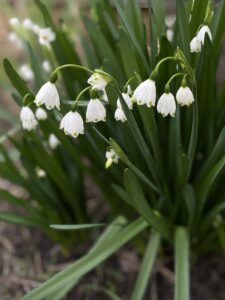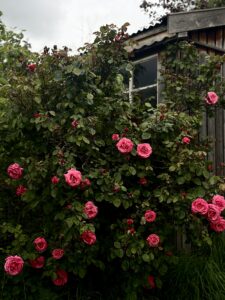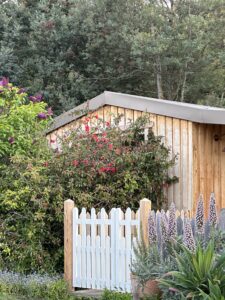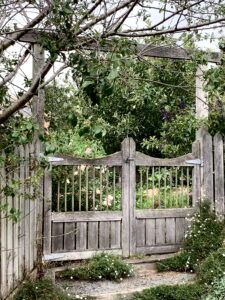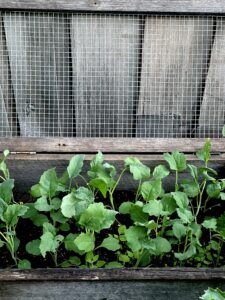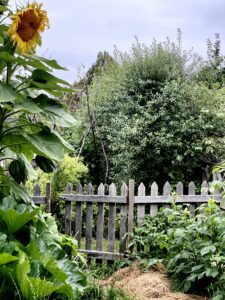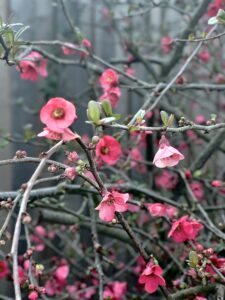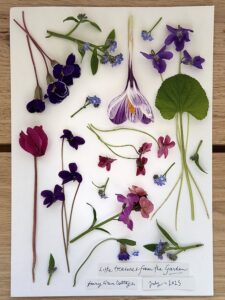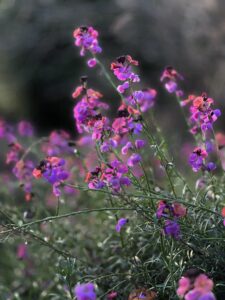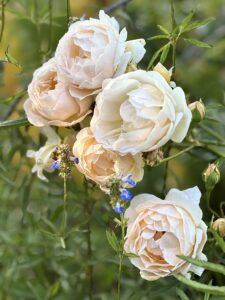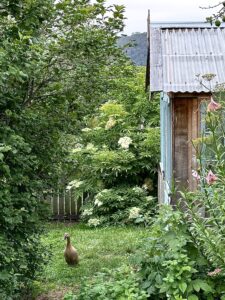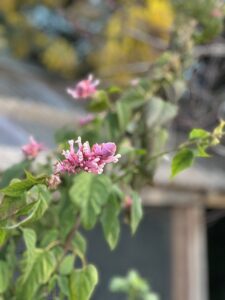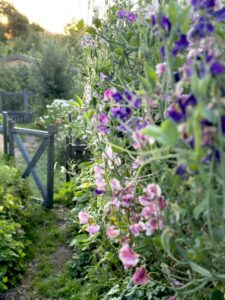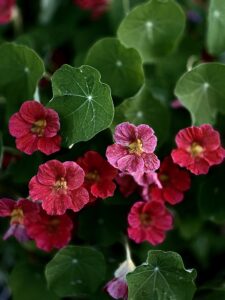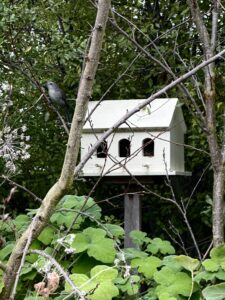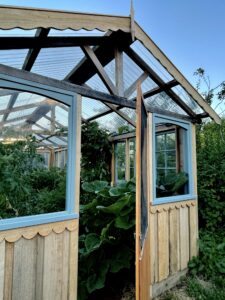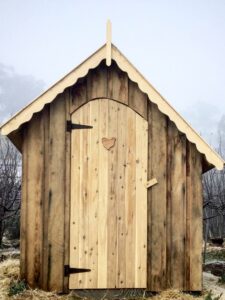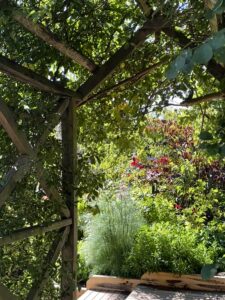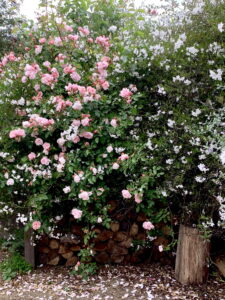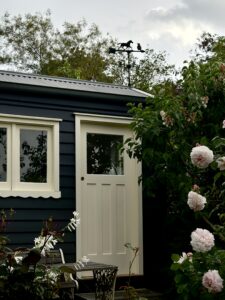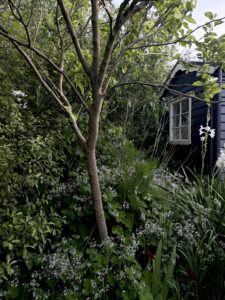Michael Van Heel ABN: 30159774409
Home
ABout
Portfolio
Contact
~ specialising in bespoke carpentry and joinery ~
Blog POSTS
Michael Van Heel. ABN: 30159774409
Plants that Rabbits, Pademelons & Possums haven’t eaten.
August 31, 2025
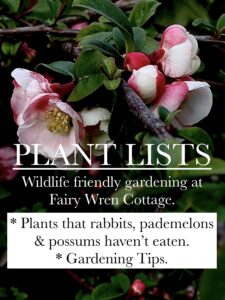
Gardening Advice.
I frequently get asked for gardening advice after clients have seen my wife Jude’s instagram account @fairywrencottage , which is named after our property Fairy Wren Cottage. Jude has an extensive knowledge of earth friendly gardening and our daughter and I follow her lead; we are a good team.
Our garden is registered with We are the ARK (Acts of Restorative Kindness).
Our climate zone is: Heat Zone 2. Cold Zone 9b.
Fairy Wren Cottage, is a 115+ yr old cottage, built on the side of a hill in the Huon Valley.
Jude, our daughter, and I have been living and gardening at Fairy Wren Cottage for over 15 years. The garden was pretty much a blank canvas when we bought the property. Although, what was growing on the property the previous owner planted in an unusual way – they dug a hole, filled it partly with concrete, then planted the tree/bush/shrub onto the concrete and refilled the hole with soil. There were also small triangle shaped garden beds made from concrete, a plant in the middle, landscape fabric, then a layer of pebbles. Apparently the pebbles were often washed/cleaned and nothing was allowed to flower (the previous owner thought the flowers were too messy). All that concrete was removed, along with a concrete wishing well that came close to tipping over the bob cat.
We have planted a big old fashioned garden. It is organic, bee friendly, and wildlife friendly.
Favouring heirloom varieties, there are food hedges, small organic orchards with rare fruit tree varieties home to heritage breed ducks and hens, wildlife areas that attract Tasmania’s endangered marsupials, and a now abundant birdlife population that visit at different times of the year or permanently call the garden home. There are areas planted with natives and plants/trees indigenous to Tasmania, perennial borders, berry patches, food hedges, a kitchen garden, and lots of flowers.
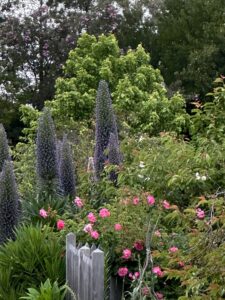
Photo: Echiums. Climbing Rose ‘Manita’. Maple. This part of the garden is not fenced off from wildlife.
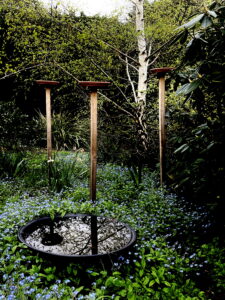
Photo: The three bird baths are specifically for the smaller birds – shallows terracotta dishes placed on rough sawn Tasmanian Oak hardwood stands, high up for protection amongst the Silver Birch branches that are underplanted with Spring bulbs. Forget Me Nots self seed. To the left there is a Bay Leaf tree, Hebes, and Dianella Tasmanica. To the right, Rhododendron. The large tub acts as a pond with stones and a branch in it to prevent birds/wildlife drowning. The wildlife have full access and graze throughout this area.
Parts of our garden are fenced off from wildlife.
But, there are also parts of the garden that are given over to wildlife, and they have full access.
In areas that wildlife have full access there is a small mix of cottage-style plants/shrubs/trees/bulbs, and a large mix of native plants and plants indigenous to Tasmania. In the beginning, we shopped at independent specialist Tasmanian nurseries, Plants of Tasmania Nursery at Ridgeway, and then we added Redbreast Plants at Margate to the list for native and indigenous plants – it’s wonderful to see the demand for native and indigenous plants reflected in the amount of small business offering these kinds of plants for sale now; it wasn’t always like this.
We do not let our dogs have access to the wildlife areas even though they are not aggressive towards wildlife. For the first couple of years when we were establishing the garden/fencing areas, the dogs did have access but as soon we stopped the dog access the wildlife numbers increased. When our daughter did have a cat, it was strictly an inside cat.
Our goal has always been to provide a safe haven for Tasmanian marsupials and birdlife.
Tasmanian marsupials that live here permanently or regularly visit or have been spotted passing through: Beetongs; Brown Bandicoots; Potoroos; Pademelons; an Echidna; a Tasmanian Devil; Endangered Eastern Barred Bandicoots; Eastern Quolls; Brushtail and Ringtail Possums.
We have many bird baths at different heights and small ponds or drinking bowls that get refreshed regularly.
We never feed the birds or wildlife. Parks and Wildlife Service Tasmania have a great information sheet called Caring for Nature. Keep Wildlife Wild.
We don’t use chemicals in the garden and limit plastics as much as possible.
Photos: Snowflakes (Leucojum vernum). Henhouse made from rough sawn Tasmanian Oak with Perpetual rose growing over the fence out of the wildlife’s reach. Rough sawn Tasmanian Oak cladding, Tasmanian Oak gates and fencing – all made and installed by me. Wildlife have full access to these areas.
From our experience, there are several reasons why animals sometimes choose to eat a plant and sometimes don’t:
Simply put, lots of wildlife like the taste of lots of things that grow in our garden. They might eat certain plants due to grazing patterns, other times because there is nothing else they like better.
It might be due to climate pattern changes such as drought, or during the wintertime when many plants/trees are dormant and there are no leaves on the lower branches of trees to nibble.
“The right plant for the right place.” A phrase coined by plantswoman Beth Chatto. Plants are stronger, more disease resistant and resilient if planted to their specific growing conditions. For example, if you are wanting to plant a garden on Bruny Island, instead of trying to plant a traditional “cottage garden or “European style garden”, embrace the indigenous and native plants that grow there – it maybe a once in a lifetime opportunity to really contribute to the habitat, flora and fauna of an area; how wonderful is that?!
Make sure to protect all young plants and trees until they are well established. Sometimes the wildlife will only favour tender young leaves and branches.
We have definitely had our fair share of plants being eaten. For years the wildlife has left certain things alone and then the next day they are chewed to the ground.
Photos: All gates, fencing and the small veg enclosure made and installed by me using Tasmanian Oak rough sawn timber.
The wildlife will always win – plant with nature, not fight against it.
We have never expected the wildlife (who have lived for generations on or around our property) to simply ignore something freshly planted because we have decided to grow it; of course they will eat it. We have never expected the wildlife to shift out because we have shifted in.
We have fenced off areas, built a Hothouse, use vegetable cages, and cloches.
We plant abundantly, which means there is usually enough for everyone. We leave fruit at the top of the trees for the wildlife and we eat the rest. The wildlife can also have the windfalls.
When we planted our small heritage fruit tree orchards, Jude planned for harvests spread over several months, not everything fruiting at once which will attract more attention from wildlife (imagine the smell of sixty fruit trees, plus berries, all ripening at once). Smaller crops harvested over several months is less conspicuous. This also means that fruit trees blossom over several months, and Jude also planned for other trees to be blossoming throughout the year, better for the bees and pollinators.
Birds will often go for fruit that we consider unripe – as soon as the fruit shows signs of being eaten, we use small draw string bags made from mesh fabric and tie them around fruiting branches until the fruit ripens.
Photos: Ornamental Quince. July treasures -Wallflowers, Forget Me Nots, Crocus, Polyanthus, Violets, Cyclamen from the garden. Wallflowers. Wildlife has access to all of these.
Plant list that Rabbits, Possums, and Pademelons haven’t eaten at Fairy Wren Cottage.
Note: I have not included native or indigenous plants/shrubs/grasses/trees.
Forget Me Nots (they self seed).
Bearded Iris (Iris x germanica).
Flanders Red Poppies (they self seed).
Narcissus (Spring bulbs e.g. daffodils, Tete a Tete miniature daffodils, jonquils).
Snowflakes (Leucojum vernum).
Lambs Ear (Stachys byzantina).
Agapanthus (cut the flowers off before they go to seed. Frogs love to hide in the strappy leaves).
Echiums.
Rosemary.
Feverfew.
Tansy.
Violets.
Wallflowers.
Hydrangeas.
Yarrow.
Potato vine.
Jasmine vine.
Rhododendron.
Camellias.
Purple Salvia (grows between 1-2metres tall).
Mexican Salvia.
Lilac.
Borage.
Nasturtiums.
Cyclamens.
Polyanthus.
Wormwood.
Eau de Cologne mint.
Bugle (Ajuga reptans).
Pelagoniums.
Rose Geranium.
Birch trees.
Magnolia.
Ornamental Flowering Currant.
Ornamental Quince, also known as Flowering Quince (Chaenomeles speciosa).
Calla lily, also known as Arum Lily (Zanteschia hybrids).
Japanese anemones.
Daphne.
Bayleaf tree.
Bog Sage (Salvia uliginosa).
Miscanthus.
Hops.
Chocolate Mint.
Verbena Bonariensis (they self seed).
Pink Valerian and Red Valerian.
Raspberries. Young Berries. Red and White Currants.
Peppermint Geranium.
Seaside Daisies (Erigeron glaucus).
Rosa rugosa roses (including Rosa rugosa ‘Freycinet’).
Sweet Peas (Lathyrus odorutus).
Herb Robert.
Honeywort (Cerinthe major).
Gladioli.
Dutch Iris.
Fritillaria Meleagris.
Hyacinths.
Bluebells.
Photos: Graham Thomas Rose underplanted with Bog Sage. Kitchen Garden. Pink Salvia 1.5-2.5m tall.
Rabbits, possums or pademelons may or may not eat:
Pansies and Violas (For the first time in fifteen years, rabbits have eaten them).
Westringia (We planted a hedge of westringia and the rabbits ate all but one. That one westringia was never touched for over ten years until it split down the middle in a storm).
Sedum ‘Autumn Joy’.
Lavender. They ate the Italian Lavender and left the French Lavender, then went back for the French Lavender weeks later.
Hebes (the undergrowth does get nibbled by Pademelons, especially the young joeys).
Pincushion Plants (Scabiosa). They will leave the plant but eat the stems and flowers.
Photos: Garden gate made by me. Nasturtiums. Grey Shrike Thrush in the tree – a pair nest each year in the bird house my daughter and I made together.
Rabbits, possums and pademelons will definitely eat:
Roses (but not Rosa Rugosa roses – they are very thorny and we think that the thorns are the deterrent).
Pineapple Salvia (Salvia elegans).
Dahlias.
Fallen fruit.
Ripe and unripe fruit (Possums climb the tree. Rabbits and pademelons can reach up to the lower fruiting branches and pull them down).
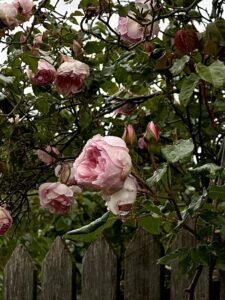
Photo: Duchess de Brabant rose grown on the inside of the fence and trails over the fence, but high up out of reach.
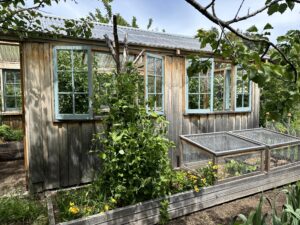
Photo: Hothouse and veg enclosures made by me.
Tips:
We grow some roses on the inside of a fence (where wildlife doesn’t have access) – the roses trail over the fence but are still high up where the wildlife can’t reach them.
We grow raspberry canes around some fruit trees that wildlife may be able to get access too – the thorny raspberries are a deterrent.
You have probably noticed that many of the plants on our list are highly scented. When planted around the base of fruit trees, highly scented plants and herbs do tend to be a deterrent (eg. Rose Geranium and Peppermint Geranium).
Protect and water all native and indigenous plants/shrubs/trees until they are established. Once establish, to test if you can take the guard off by leaving a small branch or leaves nearby to see if it gets eaten.
If we lived in a more rural setting and had a higher population of wildlife visiting our garden, we would build a large walk in fruit and veg enclosure and a fruit orchard enclosure that would include soft berries, have fenced off areas for any cottage style planting or flowers, have silver birches underplanted with Spring bulbs, leaving lots of grassed areas (which is what we already have in one part of our garden) and regenerate the rest of the property with species native and indigenous to Tasmania.
*Tip for a walk in fruit and veg enclosure: make sure to have a kick board and mesh dug 15-20cm into the ground around the perimeter of the enclosure, including under the door step. Use wire mesh that has approximately 1cm openings to allow for bees, beneficial insects and pollinators to have access to pollinate your fruit and veg. If you have mesh with large openings, snakes, mice and rats will easily have access. Be vigilant for holes dug around the perimeter, and block them back up asap. From our experience, possums and rats have chewed through strong nylon netting.
I can make walk in fruit and veg enclosures as well as a range of outbuildings.
Photos: Hothouse, Henhouse, Garden Arbour, and decking made and installed by me.
Photos: Albertine Rose and Potato Vine in November overtaking the wood shed made by me. Garden Library that was once our daughter’s cubby (yes, that is the resident Blackbird who often talks to the horse on the weathervane). Fruit trees underplanted with Peppermint Geranium outside the Garden Library made by me.
Our garden isn’t perfect – it’s a country garden, not a show garden.
If the weeds get too big and flower, we leave the flowers for the bees and chop the weed down to the ground before the flower sets seed. We’ve had epic fails and epic wins; we’ve lost whole fruit crops due to possums or climate conditions. More than once in the last five years we have looked at each other and asked if it is all worth it (Jude and I have been gardening together for 25 years). The goal posts keep changing as the climate changes, development around us happens and more wildlife becomes displaced and shifts in. But the garden is worth it, and it is where many of our family memories are made, it’s a lovely place to be and it feeds us.
Thanks for reading, happy gardening, and please let me know if you have had success with any plants that aren’t on the list.
Michael
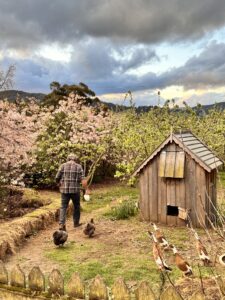
Photos by Jude Van Heel.
~
My work ranges from the smallest bespoke carpentry project right through to full home renovations.
I’m really happy to work to your designs, together with my 30 + years of carpentry knowledge and experience.
Here is the full list of my carpentry expertise:
Custom-made kitchens.
Free-standing kitchen dressers, buffets and hutches.
Free-standing and fitted pantry cupboards.
Bathroom vanities.
Laundry and Mudroom shelving, bench tops, cupboards and cabinetry.
Bedroom fitted and free-standing cabinetry and wardrobes.
Home office and studio free-standing and fitted cupboards, bench tops, desks, storage.
Bookshelves. Home Libraries.
Furniture including daybeds, window seats, tv cabinetry.
Tables and table top replacement.
Timber floorboard installation.
Architraves, skirting and picture rails.
Dado panelling, wall panelling, shiplap installation.
Timber windows.
Timber doors, french doors, hardwood and glazed.
Timber screen doors.
Timber fencing. Picket fencing.
Outdoor furniture. Tables, garden seating.
Timber gates and garden features.
Henhouses, wood storage, and potting sheds.
Well that’s quite the list but covers everything!
Quotes, Delivery, and Install throughout the
Huon Valley, Kingsborough, D’Entrecasteaux Channel Areas.
For Tasmanians living outside of these areas, due to client demand bespoke kitchens, double or single glazed doors and windows, screen doors, furniture, cabinetry, bathroom vanities, and gates can now be collected from the Huon Valley.
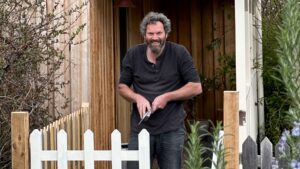
Contact
Name
Email Address
Message
If you would like to move forward with an enquiry, please fill out the contact form below.
~
Thank you for your message. I hope to get back to you as soon as possible.
Thank you!
I'll be in touch soon!
